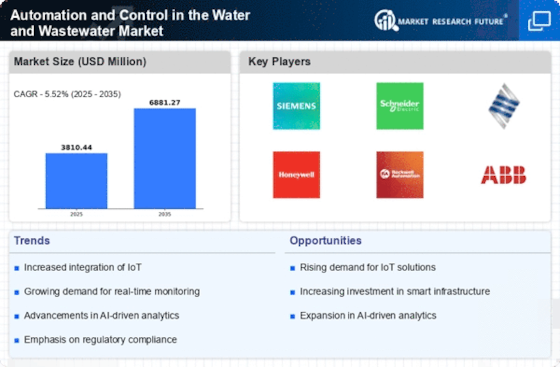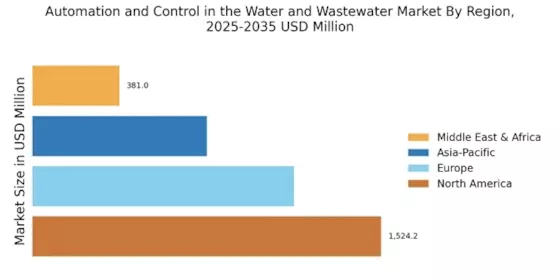Focus on Sustainable Practices
The focus on sustainable practices is becoming a pivotal driver in the Automation and Control in the Water and Wastewater Market. Stakeholders are increasingly recognizing the importance of sustainability in water management, leading to the adoption of technologies that minimize environmental impact. Automation solutions that promote energy efficiency, reduce chemical usage, and enhance resource recovery are gaining traction. For instance, advanced control systems can optimize energy consumption in treatment processes, aligning with sustainability goals. The market is witnessing a shift towards solutions that not only meet operational needs but also contribute to environmental stewardship. As sustainability becomes a priority for water utilities, the demand for innovative automation technologies is likely to grow, shaping the future of the industry.
Investment in Infrastructure Development
Investment in infrastructure development is a crucial driver for the Automation and Control in the Water and Wastewater Market. Many regions are experiencing aging water infrastructure, which necessitates significant upgrades and replacements. Governments and private entities are increasingly allocating funds to modernize water treatment facilities and distribution networks. This investment often includes the implementation of automation technologies that enhance system reliability and efficiency. According to industry reports, billions of dollars are being invested annually in water infrastructure projects, creating a substantial market opportunity for automation solution providers. As these investments continue, the demand for advanced control systems that can optimize operations and reduce costs is expected to rise, further propelling market growth.
Rising Demand for Efficient Water Management
The increasing demand for efficient water management systems is a primary driver in the Automation and Control in the Water and Wastewater Market. As urban populations grow, the need for reliable water supply and wastewater treatment becomes critical. According to recent data, water scarcity affects over 2 billion people, prompting municipalities to adopt advanced automation technologies. These technologies enhance operational efficiency, reduce water loss, and improve service delivery. Furthermore, the integration of real-time monitoring systems allows for better resource allocation and management, which is essential in addressing the challenges posed by climate change and population growth. Consequently, the market for automation and control solutions is expected to expand significantly as stakeholders seek to optimize their water management practices.
Regulatory Compliance and Environmental Standards
Regulatory compliance and adherence to environmental standards are increasingly influencing the Automation and Control in the Water and Wastewater Market. Governments worldwide are implementing stringent regulations to ensure safe drinking water and effective wastewater treatment. For instance, the U.S. Environmental Protection Agency has established guidelines that necessitate the use of advanced monitoring and control systems. These regulations compel water utilities to invest in automation technologies that facilitate compliance, thereby driving market growth. The need for real-time data collection and reporting systems is paramount, as it enables utilities to demonstrate compliance with environmental standards. As a result, the market for automation solutions is likely to witness robust growth, as utilities prioritize investments in technologies that ensure regulatory adherence.
Technological Advancements in Automation Solutions
Technological advancements in automation solutions are reshaping the landscape of the Automation and Control in the Water and Wastewater Market. Innovations such as artificial intelligence, machine learning, and the Internet of Things are being integrated into water management systems, enhancing operational efficiency and decision-making processes. For example, predictive maintenance technologies can reduce downtime and maintenance costs by anticipating equipment failures. The market for these advanced automation solutions is projected to grow, with estimates suggesting a compound annual growth rate of over 10% in the coming years. This growth is driven by the need for smarter, more efficient systems that can adapt to changing environmental conditions and operational demands, thereby improving overall service delivery in water and wastewater management.

















Leave a Comment